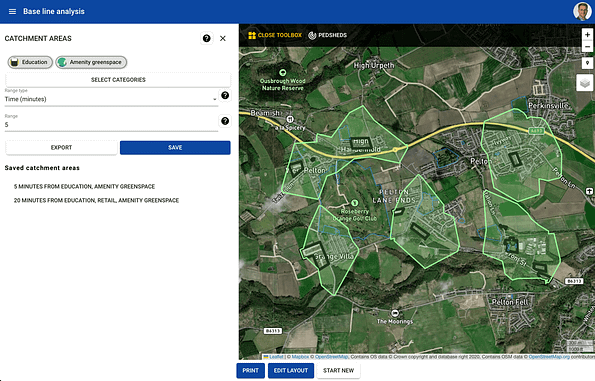The success of any construction or regeneration project depends heavily on the strength of its business case and the evidence of need. This is where a well-informed project brief comes in, providing a practical design response from architects, addressing concerns of external stakeholders and helping secure funding and resources to make the project a reality.
But success isn't just about meeting financial targets - it's also about designing for the user, whether they're tenants, buyers, shoppers, or visitors to the area. And while many may focus solely on financial metrics, it's becoming increasingly important for organisations to demonstrate a broader net positive impact on current and future residents, beyond just the bottom line.
With the increasing awareness towards project impacts in the investment and funder community, many projects need a much broader framework or set of KPIs to move towards success. In this context, our blog on ESG is a must-read for anyone in the housing and property development industry looking to get started on a mission-led approach to their projects. Read it here: Getting started with ESG for housing and property development.
This article here looks at the role of project briefs that define the planning project from the start. A project brief can positively affect the project team and external stakeholders.
Importance of briefs for funding success
A well-crafted project brief can be easily adapted into other materials and effectively communicated to project investors, funders, and grant funders. In fact, real-estate investment funds are increasingly seeking out impact-led planning projects that align with their ESG (Environmental, Social, Governance) criteria. For example, MAN group, a leading impact-led investor with many investments in affordable housing, states:
“For many clients, we feel that our duty is best served by fundamentally integrating ESG (Environmental, Social, Governance) factors into the investment process.”
As an investor, MAN group, has three norms or roles that they apply in investing:
ESG factors: “considering or applying ESG criteria in the investment decision making process
Stewardship: enhancing the value and interest of our clients’ assets through voting and active engagement
Education & advocacy: “participating and education on responsible investing in the investment community.
A well-developed project brief is not only essential for guiding the design and execution of a project but also serves as a critical tool for communicating with project investors and funders. As ESG considerations become increasingly important for investors, aligning with their criteria can provide access to much-needed funding and support. By understanding the importance of ESG factors and actively integrating them into our project planning and execution, we can create more sustainable and impactful projects that benefit not only our stakeholders but also the broader community.
How does place data help shape great project briefs?
A good brief makes you enthusiastic and eager to drive the project forward. A brief can be a call to action for the potential future outcomes that can be achieved or realised. Great briefs are informed by residents needs, assets, and existing place characteristics.
Here are six benefits how place analytics and data are essential to generating impact-led project briefs that attract funding for mixed use and residential projects.
- Improved design response: With access to detailed place analytics and data, designers and planners can develop a more informed and targeted design response that addresses the specific needs of the community, resulting in more successful and impactful projects.
- Understanding current residents: Place analytics and data can help identify the demographics of the target market or eventual buyers/tenants, including age, income, family status, and interests. This information is crucial for designing a project that caters to the needs and desires of potential residents, leading to higher occupancy rates and return on investment.
- Better resource allocation: Understanding the characteristics and needs of a particular area can help designers and planners make more informed decisions about how to allocate resources and prioritize interventions, ensuring that investment is targeted where it is most needed.
- Understanding the local economy: Place analytics and data can help investors and developers understand the local economy, including employment trends, industry sectors, and consumer behavior. This information can help identify opportunities for mixed-use developments that support the local economy and attract visitors.
- Understanding existing housing: Understanding the existing housing stock and its condition can inform decision-making and prioritization of renovation or new development projects, leading to more efficient use of resources and improved quality of life for residents.
- Identifying demand for specific amenities: Place analytics and data can help identify demand for specific amenities, such as parks, public transportation, retail, and restaurants. This information can help developers design mixed-use projects that cater to the needs of the community and attract residents.
- Assessing environmental impact: Place analytics and data can help assess the needed environmental impact or improvements of a project, including air quality and energy efficiency. This information is essential for impact-led projects who prioritize ESG factors in the design development process.
For more insights on this topic, take a look at these articles: Understanding health and wellbeing in Bensham through local data.
How frameworks and analytics tools help shape project briefs
To establish aspirations for a project's outcome and set guidelines for its delivery, it's beneficial to consider design and development frameworks. While not required in the project brief, these frameworks can provide an excellent point of reference for the project. Many public funding bodies, such as Homes England, now require a review of projects through an urban design lens, with the Building for a Healthy Life framework being commonly referenced.
For larger developments, quality frameworks for urban design are critical to ensure that the place and people's broader factors are considered in design development. To learn more about project quality frameworks, check out this article on the value of development accreditations for construction projects by PlaceChangers: Building for Success: How BREEAM Communities and Building for Healthy Life Assessment improve construction projects
Importance of data and evidence for briefs
Generating successful project briefs relies heavily on gathering and analyzing relevant place data. With an overwhelming amount of information available on any given place, clear frameworks and easy-to-use data tools can be invaluable.
For instance, PlaceChangers place analytics tool ('Site Insights') offers planners powerful geospatial analytics to create a place baseline that focuses on attributes critical to impact-led investment. While frameworks like Building for a Healthy Life can provide essential guidance for desired outcomes, data tools like Site Insights add a necessary data dimension to project briefs.

Planning for walking distance on PlaceChangers
For planners, architects, and project owners the benefits of validated data analytics tool include:
- Reduced need to re-establish and maintain complex GIS systems or setups, which are better served for later-stage technical analysis.
- Fast means to establishing relevance of data by contextualising evidence to a specific place in question
- Benchmarking critical insights against national or regional levels to identify a place's strengths and weaknesses easily
- Generation of powerful visual summary of relevant indicators to use in briefs
- Allowing for the capture of additional evidence or insights on a specific piece of land or place geographically to complement briefs with a living site map.
In summary, place analytics can help architects, planners, and developers answer crucial questions that can set a project brief off in the right direction. Additionally, relying on validated and reliable information can make conversations with councils and other stakeholders more productive, focusing discussions on aspects that can be worked on collaboratively.
Explore the PlaceChangers planning toolkit

PC Engagement - market leading planning consultations
Set up powerful map surveys and polls based on the changes that may come up on your estate and prioritise future planning interventions more easily.

PC Site Insights - Powerful analytics tool for understanding places
Start to make use of location data and enrich your community engagement planning with insights on local people. Add in your own data sources and gather analytics in one place.
